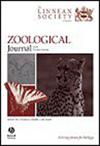Diamesinae (摇蚊科:双翅目)的多焦点系统进化为两栖支系的进化提供了新见解
IF 2.8
2区 生物学
Q1 ZOOLOGY
引用次数: 0
摘要
摇蚊亚科(Diamesinae)是摇蚊科(Chironomidae)的一个亚科,其物种生活在寒冷的地层或低营养透水生境中,分布于除南极洲以外的全球各地。几乎所有的摇蚊都具有低温恒温的生态特性,因此在热带纬度地区,除了高海拔地区外,都不存在典型的两栖模式。最近的关注点集中在物种的发现上,而对属和部族层面的进化关系仍然缺乏足够的了解。目前的分类方法意味着两个半球(北半球和南半球)都存在类似的进化多样性。为了验证这一概念,我们使用了六个遗传标记(18S、28S、CAD1、COI-5p、COI-3p 和 COII)和化石校准,建立了该亚科的时间校准系统发育。澳大拉西亚和北寒带原脚亚目确实是互为单系,其分化年代估计为侏罗纪(130-196,164 Ma)。北半球的原脚亚目(Protanypodini)以前被认为是二趾亚目(Diamesinae)中的一个支系,现在被排除在外,并被提升为原脚亚目(Protanypodinae stat.祖先澳大利亚的Diamesines可能起源于南美洲,在白垩纪-古近纪期间先后到达新西兰、澳大利亚和南非。全北区的Diamesini和Boreoheptagyiini可能起源于古北界东部,并进一步扩散/变异到古北界西部、近北区、东区,并很可能向南扩散到东非山地和婆罗洲。本文章由计算机程序翻译,如有差异,请以英文原文为准。
A multi-locus phylogeny for the Diamesinae (Chironomidae: Diptera) provides new insights into evolution of an amphitropical clade
Diamesinae is a subfamily of Chironomidae, whose species live in cold lotic or oligotrophic lentic habitats with global distribution excepting Antarctica. The cool stenothermic ecology of nearly all diamesines produces a typical amphitropical pattern of absence at tropical latitudes, except at high elevation. Recent attention has focused on the species discovery, while evolutionary relationships at the generic and tribal level have remained inadequately understood. Current classification implies analogous evolutionary diversification in each hemisphere (boreal and austral). To test this concept, we used six genetic markers (18S, 28S, CAD1, COI-5p, COI-3p and COII) and fossil calibrations to produce a well-supported and resolved time-calibrated phylogeny of the subfamily. Austral and boreal diamesines indeed are reciprocally monophyletic lineages, with estimated Jurassic divergence (130-196, 164 Ma). The boreal Protanypodini, previously understood to be a tribe within Diamesinae, is excluded and elevated here to subfamily rank as Protanypodinae stat. nov. Ancestral austral diamesines probably originated in South America and successively reached New Zealand, Australia and South Africa during the Cretaceous-Paleogene. The Holarctic tribes Diamesini and Boreoheptagyiini probably originated in the Eastern Palaearctic with further dispersal/vicariance into the Western Palaearctic, Nearctic, East, and very likely dispersed southwards to montane East Africa and Borneo.
求助全文
通过发布文献求助,成功后即可免费获取论文全文。
去求助
来源期刊
CiteScore
6.50
自引率
10.70%
发文量
116
审稿时长
6-12 weeks
期刊介绍:
The Zoological Journal of the Linnean Society publishes papers on systematic and evolutionary zoology and comparative, functional and other studies where relevant to these areas. Studies of extinct as well as living animals are included. Reviews are also published; these may be invited by the Editorial Board, but uninvited reviews may also be considered. The Zoological Journal also has a wide circulation amongst zoologists and although narrowly specialized papers are not excluded, potential authors should bear that readership in mind.

 求助内容:
求助内容: 应助结果提醒方式:
应助结果提醒方式:


